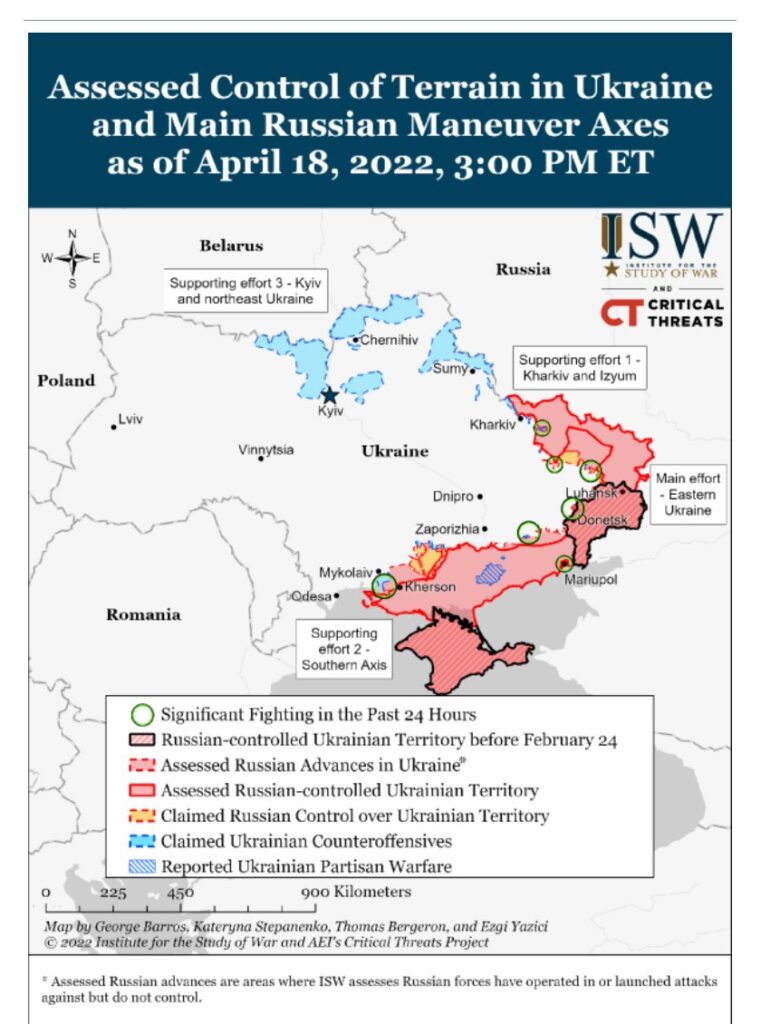
| Russian Offensive Campaign Assessment Mason Clark, George Barros, Kateryna Stepanenko, and Karolina Hird April 18, 6:30pm ET |
| Russian forces began a new phase of large-scale offensive operations in eastern Ukraine on April 18 likely intended to capture the entirety of Donetsk and Luhansk oblasts. Russian forces have been concentrating reinforcements—including both newly-deployed units and damaged units withdrawn from northeastern Ukraine—to the Donbas axis for several weeks. Russian forces conducted large-scale assaults focused on Rubizhne, Popasna, and Marinka with heavy artillery support on April 18 after previously conducting only localized attacks and shelling along the line of contact. Russian forces have not secured any major territorial gains as of publication. The Russian offensive in the east is unlikely to be dramatically more successful than previous Russian offensives, but Russian forces may be able to wear down Ukrainian defenders or achieve limited gains. Russian forces did not take the operational pause that was likely necessary to reconstitute and properly integrate damaged units withdrawn from northeastern Ukraine into operations in eastern Ukraine. As we have assessed previously, Russian forces withdrawn from around Kyiv and going back to fight in Donbas have, at best, been patched up and filled out with soldiers from other damaged units, and the Russian military has few, if any, cohesive units not previously deployed to Ukraine to funnel into new operations.[1] Frequent reports of disastrously low Russian morale and continuing logistics challenges indicate the effective combat power of Russian units in eastern Ukraine is a fraction of their on-paper strength in numbers of battalion tactical groups (BTGs). Russian forces may certainly be able to wear down Ukrainian positions in eastern Ukraine through the heavy concentration of firepower and sheer weight of numbers, but likely at a high cost. A sudden and dramatic Russian offensive success remains highly unlikely, however, and Ukrainian tactical losses would not spell the end of the campaign in eastern Ukraine, much less the war as a whole. Key Takeaways Russian forces likely began large-scale offensive operations in Donetsk and Luhansk oblasts focused on Rubizhne, Popasna, and Marinka. Russian forces may be able to gain ground through the heavy concentration of artillery and numbers. However, Russian operations are unlikely to be dramatically more successful than previous major offensives around Kyiv. The Russian military is unlikely to have addressed the root causes—poor coordination, the inability to conduct cross-country operations, and low morale—that impeded prior offensives. Successful Ukrainian counterattacks southeast of Kharkiv will likely force Russian forces to divert some units intended for the Izyum offensive, but Ukrainian forces are unlikely to completely sever Russian lines of communication north of Izyum in the coming days. Ukrainian defenders in Mariupol continued to hold out against heavy Russian artillery and air bombardment. |




